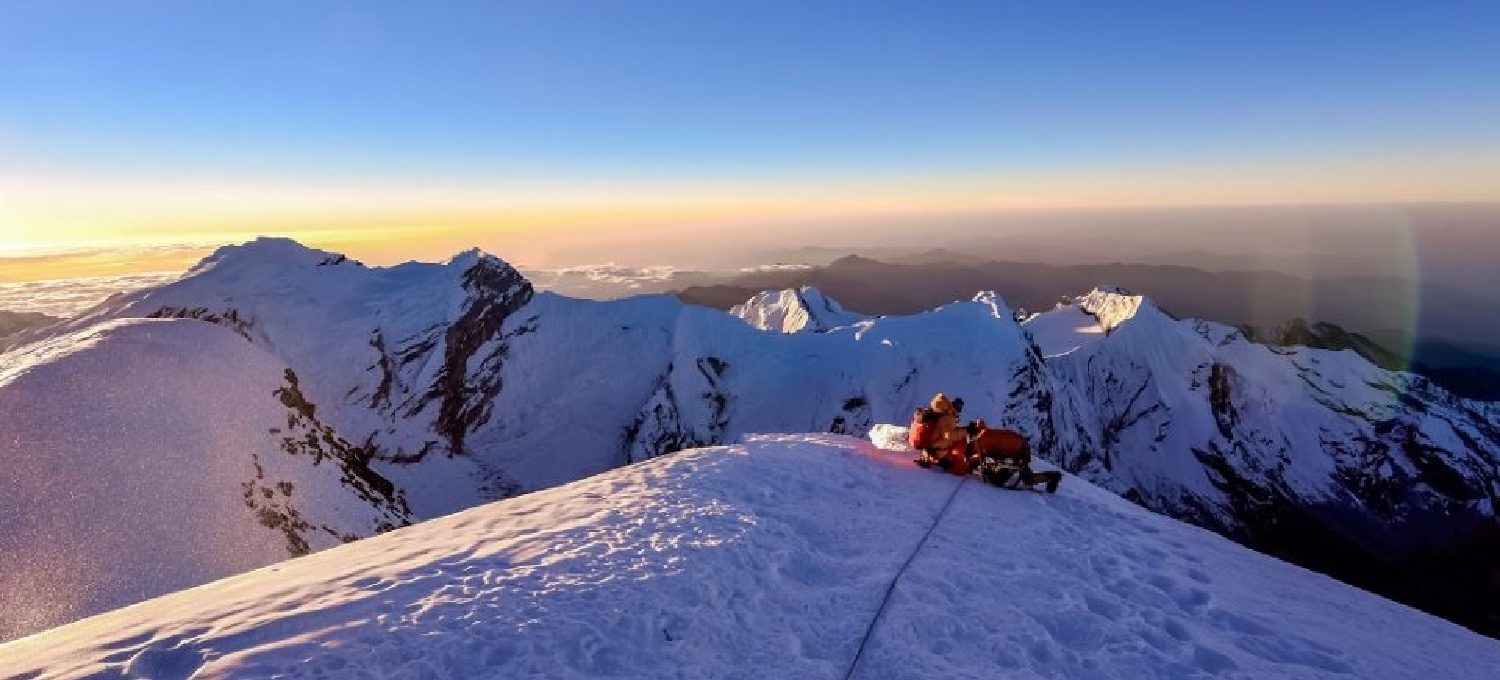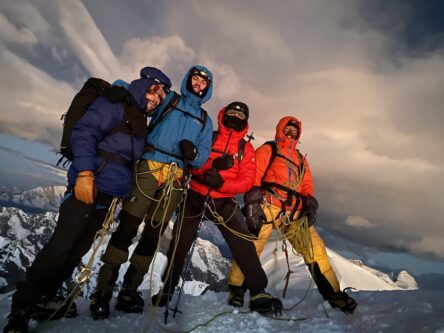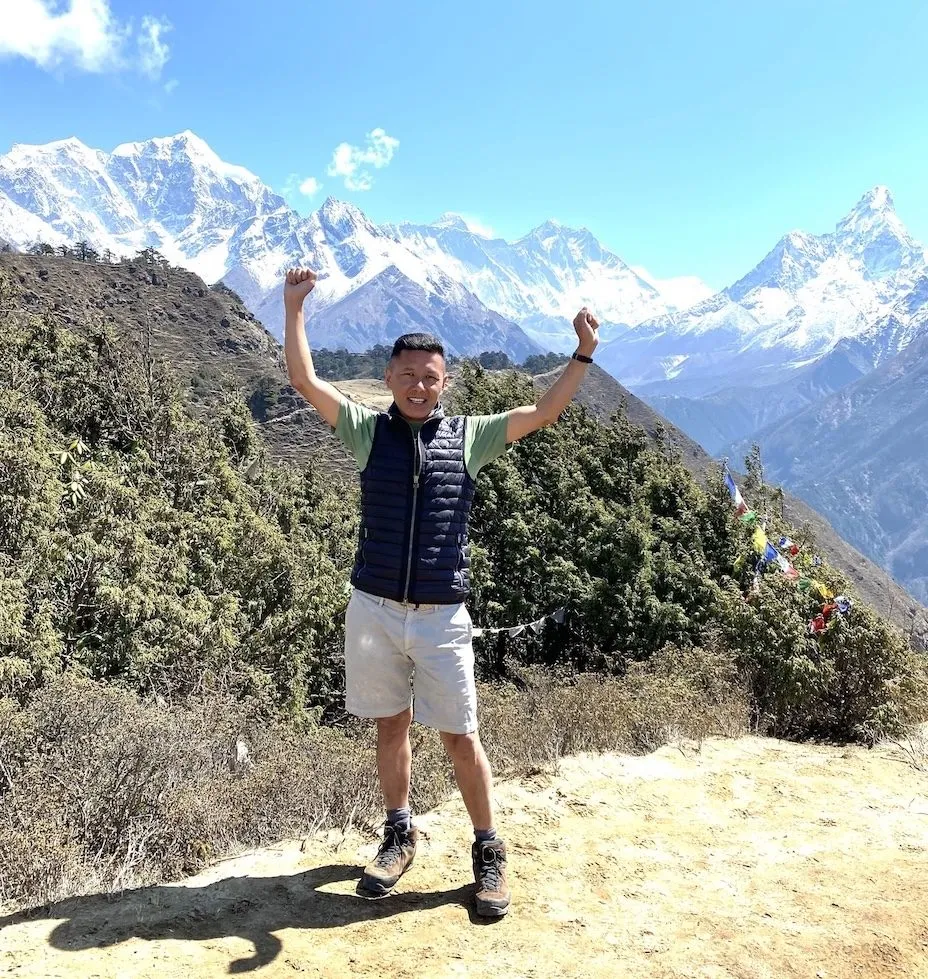- 14 Days
- 6,461m

Mera Peak Climbing takes us to the summit of Mera Peak (6,476m/21,247ft) which is Nepal’s highest trekking peak. During the spring and autumn seasons, we preferably climb Mera Peak as it is the best time to climb the mountain for its stunning Himalayan views. Five 8,000m peaks can be seen from the summit, including Everest, Lhotse, Cho Oyu, Makalu and Kanchenjunga.
Trip to Mera Peak Climbing begins with an adventurous flight to Lukla, trek to Mera Peak Base Camp (5,400m) east of Lukla, and on the final day of the summit to Mera Peak. The routes are covered with rhododendron flowers (in spring), silver fir, and Jennifer. After passing the Mera Peak Base Camp, there are no lodge for foods and accommodation. Now, we have to set up tents around high camp and to be prepared for accommodation in a tent.
Although non-technical, the peak is at high altitude and this is something to consider when deciding whether this journey is for you. Refresher training will be given prior to reaching High Camp. The itinerary has been designed to allow for a gradual acclimatization and a reserve day has been built in the in case of bad weather on the summit day.

It is possible to climb the Mera Peak all year round, although summer time is not recommended as it’s the monsoon period. However, spring and fall seasons are considered to be the best and most suitable seasons of the year for any climbing trip in the Himalayas.
September through November is the fall season and the temperatures are moderate and the weather appears to be very clear. March through early June is the spring season and also Nepal’s busiest climbing season of the year.
Welcome to the Himalayas, one of our representatives will pick you from the Airport and drive you to your respective hotel.
Once you reach the hotel you will check in and rest for a while. The remaining day you can discover Thamel looking at shops and eating at a restaurant.
Today in the morning, our team will meet you to review the equipment you have brought and take you to the gear rental shop. Before you head off to the Himalayas, we will make sure that you have quality climbing boots that fit well.
Today, there will also be a trip briefing on last-minute specifics about your trek and an early lights-out: you have a big day ahead.
Mera Peak climbing adventure starts on the third day with a scenic flight from Manthali, airport to Tenzing Hillary Airport at Lukla (2,800m).
Update: Kathmandu to Lukla flight has been shifted to Manthali airport, Ramechhap. During peak seasons spring (March to May) and fall (September to November) due to increased traffic as well as renovation in Kathmandu airport since March 2019. Manthali airport can be reached within 4 to 5hour drive from Kathmandu.
This means you need to wake up very early in the morning around 2:30 am to go for a drive and catch your early morning Lukla flight from Manthali. Night travel is required as there are only few hotels available in Mathali and the flights to Lukla all leave in the morning.
The flight is itself a remarkable and exciting 20 minutes across the mountain range. We walk along the jungle trail, cross the bridge over the HandiKhola and reach Surke village. Now, we continue south and cross the Chutok La Pass before we arrive the small settlement of Paiya (also known as Chutok).
Note: if you wish to avoid the night road journey to Manthali talk to us about taking a helicopter directly from Kathmandu to Lukla.
After breakfast, we’ll go down for a while and reach a small bridge. The trail is slippery from here until we cross the Kari La Pass. We walk through the Rhododendron and Bamboo forests along a narrow mountain trail. Our today’s journey, we will enjoy the wonder of the Dudhkoshi Valley. We continue our journey to Panggom village where people depend on farming and trading.
We’ll start our trek after breakfast, as always. After a trek out of Panggom, we cross the Panggom La Pass. Then we ascend up and continue on a steady path.
We pass PesengKharkaKhola first then, after walking for some time, we reach PeengKharkaDanda. We cross NingsowKhola (stream) before we reach the Ningsow village.
After hot breakfast, we’ll start our trek. We ascend first, then descend for a while and climb a little further to reach RamailoDanda. From here we have an extraordinary view of Mera Peak and Salpa.
After ascending and descending on our route, we join the Makalu Barun National Park. Our trek from here to ChhatraKhola is named PasangLhamu trail. En route, if we’re lucky enough, we also might encounter the rare Red Panda.
After breakfast at Chhatra Khola. We will hike towards the north on the main trail to Mera Peak. After hiking on a trail next to the Majang Khola, we’re going to combine it with another trail that moves along the HinkuKhola.
Our trail continues straight ahead towards Tashing Ongma, which has seasonal tea shops. We continue our trek and cross the bridge over the SanuKhola before we reach Kothe.
Today, we’ll walk along the Hinku Khola ridge in the shadow of the Mera Peak. We have lunch at Gondishung, the summer herder’s settlement on the west bank of the HinkuDrangka.
Beyond Gondishung, we’re passing 200-year-old Lungsumgba Gompa where we can find Mera Peak scripted in rock along with its route to summit the Mera peak. A short journey takes us to Thangnak, which is a summer grazing place with primitive shops and lodges.
After breakfast, time to Leave Thaknak and then follow the side moraine of Dig Glacier to Dig Kharka, which offers great views of Charpate Himal. The trail ascends through the moraines to the snout of the Hinku-Nup and Shar glaciers, then climbs more steeply to Khare.
From here, we can see the northern face of Mera Peak, which will be a wonderful experience. After lunch, we can walk around Khare.
Today is solely for acclimatization and training for preparing ourselves for the Mera Peak summit. Our climbing leader will help us train climbing techniques anddemonstrate the best way to use our climbing gears, such as ice axes, harnesses, climbing boots and crampons.
Today you walk through the boulders scattered along a steep trail to reach the Mera Peak Base Camp. Crossing the Mera La Pass, you will reach the Mera High Camp. Our path is along a rocky trail, which can be dangerous if it has recently snowed, as there are a number of crevasses here.
We’re making our way to the top of the rock band, which is marked by a large cairn. Then we set up a high camp and enjoy breathtaking views of Mt. Everest,Cho Oyu, the south face of Lhotse,Makalu, Nuptse, and Baruntse, Chamlang.
Early in the morning at around 2:30 am after breakfast, we’re heading towards the summit. We reach up to 6000m by sunrise. The slope rises for a section behind the ridge, and the summit comes back into view. At the foot of the final steep summit cone, we can use a fixed rope if the climbing leader considers it necessary. The summit is just a few meters away.
After a grueling climb, we finally reach the summit of Mera Peak. From the summit, we can get the most spectacular view of at least five of the fourteen 8000m peaks in the world. Almost all of this spectacular view can be seen from the site of the high camp. We spend some time at the summit to allow you to enjoy the beauty and capture it on camera. Then we descend to Khare.
This day will be set aside as a contingency in case we are unable to reach the summit of the Mera peak on the desired day due to bad weather or any other unforeseen reason. However, this day will not be required if the trip goes smoothly.
After breakfast, we’ll start a trek from Khare to Kothe along the same trail we’ve used before. Upon reaching Kothe, we celebrate our success in completing the Mera Peak summit by tasting local beers and wines with our expedition team.
Today is your last day in the Himalayas. Cross the next pass, the Zatrwa La at 4.600m. It all seems like a natural day’s walk now. Gazing in the Himalayas, such as Kongde Peak, Cho Oyu, NumburHimal and Kusum Khangru, makes us both peaceful and sad. Sad to leave such a beautiful landscape. Now the Lukla Valley is ahead of us and we’re continuing the hike to Lukla.
Our arrival in Lukla brings us an evening at a proper hotel and, traditionally, a party with your expedition crew: you made it!
Thanks to the great teamwork and perseverance, you have accomplished a physical feat that others can only dream. This is your last night on the Himalayas, which can be bittersweet.
Flights from Lukla to Kathmandu are usually scheduled early in the morning to avoid strong winds.
Please note that the flight may sometimes get delayed or canceled due to weather conditions. In that case, we expect the guest to be patient.
We’ll take a scenic flight back to Kathmandu or Manthali across the Himalayas. Arrive in Kathmandu, you can take a rest or spend the rest of your day strolling around Thamel.
In the evening, we will have a farewell dinner in a typical Nepalese restaurant with culture show.
Today is rest and relax throughout the day.
It’s time to say goodbye to Nepal. Enjoy your final moments in Kathmandu with a cafe breakfast, a city walk.
As per your flight schedule, our representatives will drop you off at the Airport.
Mera Peak is not a difficult climb compared to other peaks like Island Peak or Lobuche Peak. Technically, Mera Peak is not difficult, but the altitude of Mera Peak is higher than others.

I was born in the mountains, and raised among some of the highest peaks on Earth. I am a proud native Sherpa. My home village of Sailung, Daduwa lies in the Ramechhap District in the Eastern part of Nepal, not far from the Everest region, the world’s highest mountain.
The specialist, I design your trip to the Himalayas; I have explored and guided the country and its regions many times, and I live here. My first-hand knowledge gives you the belief that no other travel company can match our expertise in helping you plan your trip to the Himalayas of Nepal, Bhutan & Tibet.
Since its start, Magical Summits has been super-powered by you, our community; when you “travel” it, we create it. We’re on a mission to make travel better with clean, award-winning adventures that are sustainable and conscious of the planet we share.
Thank you for being a part of our journey.
